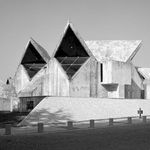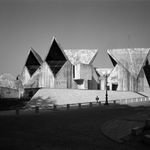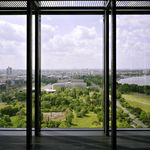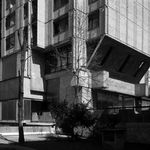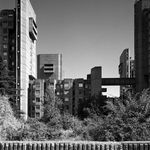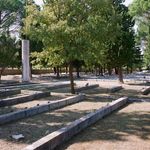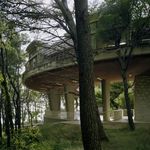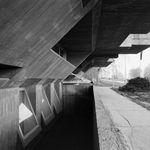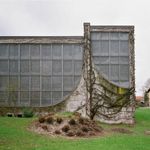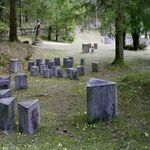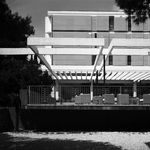Unfinished modernisations
UNFINISHED MODERNISATIONS / BETWEEN UTOPIA AND PRAGMATISM
Architecture and urban planning in the former Yugoslavia and the successor states
Croatian Academy of Sciences and Arts (HAZU), Zagreb
opening: Friday, 24 January 2014 at 19:00
After successful presentation in Maribor the exhibition Unfinished modernisations/between utopia and pragmatism will be displayed at Croatian Academy of Sciences and Arts in Zagreb. The presentation of architectural and large-scale urban planning projects which mark the period of (socialist) Yugoslavia is a long-expected event that will focus on the milestones and visions of the (unfinished) modernisations of cities during socialism as well as answer the questions about their role and legacy in the successor countires. The exhibition focuses on the physical space, e.g. on the production of city respectively as one of the fundamental means of socialist modernisation; and on the role that architecture had played in this production. However the exhibition also interferes with symbolic spaces in which this production unfolded, such as geopolitical, cultural, economic and ideological spaces.
During socialist Yugoslavia, modernisation was presented unilaterally like an everyday collective achievement that should reveal the progress of workers' self-management and make people feel proud of it. The life of Yugoslavs was thus marked by megalomaniacal, almost utopian projects in the fields of industry, energetics, traffic logistics, urban planning. On the other hand, today this socialist utopianism is often a synonym for or taken as the "original sin" of unsuitable economic structures, ecological problems and social conflicts. This project will review and present characteristic architectural and urban planning practices from the socialist period in relation to the social context from which they arose and define their current image and character. By encapsulating the collective works of young researchers from Croatia, Macedonia, Bosnia and Herzegovina, Montenegro, Serbia and Slovenia, the exhibition addresses, next to the aesthetic and technological perfection of the architectural and urbanistic achievements, the social viewpoint of the processes that influenced the development, progress and collapse of Yugoslavia. The relevance of the projects will be estimated on the basis of the contribution of these achievements to the formation of the public sphere. Another important project goal is to challenge the (internationally acclaimed) uniform belief about the period of urban modernisation in former Yugoslavia and to promote the diversity of cultural identities in the region.
"Informed by pragmatic motives, architecture in Yugoslavia was dominantly oriented to production, although in this pragmatism it was optimistic and did take account of the public good. Built architecture was thus a fairly truthful reflection of the creative capacities of the local architectural community and its ability to act. Although some progressive designs were put aside, unbuilt and incomplete, the built environment in Yugoslavia faithfully images the relation between ambitions and capacities." (Maroje Mrduljaš)
The exhibition presents numerous architectural projects, ranging from tourist experiments on the Adriatic coastline, concepts for new cities and presentation pavilions at international exhibitions, to notorious public edifices and historical memorials in all the former Yugoslav republics starting with the communist takeover in 1945 to the collapse of the Socialist Federative Republic of Yugoslavia in 1991. Through a new approach and audaciousness brought by the timely and political side step from modern history, it is the purpose of the project to re-examine the socialist architectural legacy of Yugoslavia and to awaken the strong and productive connections that are present at every step in the urban space of the former common state! The project is a result of a two-year collaboration of several institutions and the research work of over 50 experts, especially architecture historians, critics and activists. Institutions: UGM/Maribor Art Gallery (Maribor), UHA/Croatian Architects' Association (Zagreb), MAO/Museum of Architecture and Design (Ljubljana), DAB/Association of Belgrade Architects, KOR/Coalition for Sustainable Development (Skopje) and Oris, House of Architecture (Zagreb); researchers: Dražen Arbutina (CRO), Luciano Basuari (CRO/CL), Alenka Di Battista (SI), Branko Belaćević (SR), Dafne Berc (CRO), Tamara Bjažić Klarin (BIH), Dr. Petra Čeferin (SI), Matevž Čelik (SI), Sonja Damčevska (MK), Dr. Tanja Damjanović Conley (SR), Ana Đokić (SR/NL), Vjekoslav Gašparović (CRO), Dr. Nika Grabar (SI), Jelena Grbić (SR), Jelica Jovanović (RS), Emil Jurcan (CRO), Ivan Kučina (SR), Višnja Kukoć (CRO), Dr. Vladimir Kulić (SR/USA), Lana Lovrenčić (CRO), Martina Malešič (SI), Nebojša Milikić (SR), Maroje Mrduljaš (CRO), Mark Neelen (NL/SR), Divna Penčić (MK), Dinko Peračić (CRO), Vesna Perković-Jović (CRO), Dragana Petrović (SR), Marko Sančanin (CRO), Dubravka Sekulić (SR), Antun Sevšek (CRO), Dr. Luka Skansi (CRO/SI/IT), Biljana Spirkoska (MK), Jasna Stefanovska (MK), Helena Sterpin (CRO), Irena Šantevska (SR), Ines Tolić (CRO/IT), Milica Topalović (SR/BE), Elša Turkušić (BIH), Dr. Nina Ugljen Ademović (BIH), Maja Vardjan (SI), Miranda Veljačić (CRO), Hela Vukadin - Doronjga (CRO) and Dr. Bogo Zupančič (SI). The exhibition's curators are asserted young experts: Maroje Mrduljaš, responsible editor of the Croatian Magazine for Architecture and Culture Oris; Vladimir Kulić (SR/USA), assistant professor at the Faculty of Architecture at the Florida Atlantic University; Matevž Čelik (SI), director of the Museum of Architecture and Design, and Simona Vidmar, curator at the Maribor Art Gallery.
Curators: Maroje Mrduljaš (HR), Vladimir Kulić (SR/USA)
Cor-curators: Antun Sevšek (CRO)
Project Partners: DAB/Association of Belgrade Architects (SR), KOR/Coalition for Sustainable Development (MK), Hiša Oris (CRO), MAO/Museum of Architecture and Design (SI), UGM/Maribor Art Gallery (SI), UHA/Croatian Architects' Association (CRO).
Project is supported by:
With the support of the Culture Programme of the European Union
This project has been funded with support from the European Commission. This publication [communication] reflects the views only of the author, and the Commission cannot be held responsible for any use which may be made of the information contained therein.
